
Crash is a novel by English author J. G. Ballard, first published in 1973 with cover designed by Bill Botten. It is a story about car-crash sexual fetishism: its protagonists become sexually aroused by staging and participating in real car-crashes, inspired by the famous crashes of celebrities.

James Graham Ballard was an English novelist, short story writer, satirist, and essayist known for provocative works of fiction which explored the relations between human psychology, technology, sex, and mass media. He first became associated with the New Wave of science fiction for post-apocalyptic novels such as The Drowned World (1962), but later courted controversy for works such as the experimental short story collection The Atrocity Exhibition (1970), which included the 1968 story "Why I Want to Fuck Ronald Reagan", and the novel Crash (1973), a story about a renegade group of car crash fetishists.
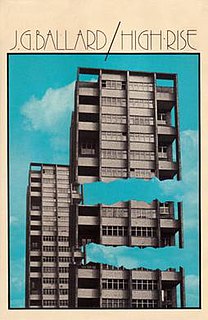
High-Rise is a 1975 novel by British writer J. G. Ballard. The story describes the disintegration of a luxury high-rise building as its affluent residents gradually descend into violent chaos. As with Ballard's previous novels Crash (1973) and Concrete Island (1974), High-Rise inquires into the ways in which modern social and technological landscapes could alter the human psyche in provocative and hitherto unexplored ways. It was adapted into a film of the same name, in 2015, by director Ben Wheatley.
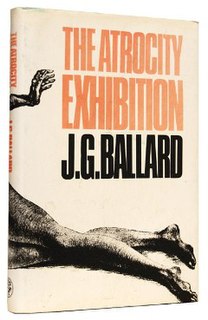
The Atrocity Exhibition is an experimental novel of linked stories or "condensed novels" by British writer J. G. Ballard.

The Crystal World is a science fiction novel by English author J. G. Ballard, published in 1966.

Concrete Island is a novel by British writer J. G. Ballard, first published in 1974.
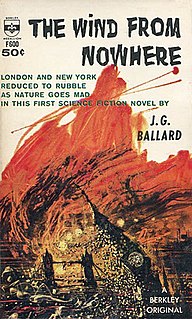
The Wind from Nowhere is a science fiction novel by English author J. G. Ballard. Published in 1961, it was his debut novel. He had previously published only short stories.
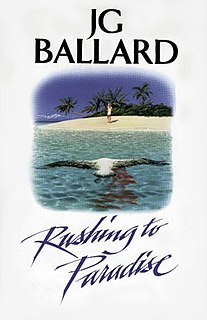
Rushing to Paradise is a novel by British author J. G. Ballard, first published in 1994.

Myths of the Near Future is a collection of science fiction short stories by British writer J. G. Ballard, first published in 1982.
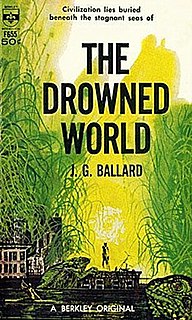
The Drowned World is a 1962 science fiction novel by British writer J. G. Ballard. The novel depicts a post-apocalyptic future in which global warming caused by heightened solar radiation has rendered much of the Earth's surface uninhabitable. The story follows a team of scientists researching environmental developments in a flooded, abandoned London. The novel is an expansion of a novella of the same title first published in Science Fiction Adventures magazine in January 1962, Vol. 4, No. 24.
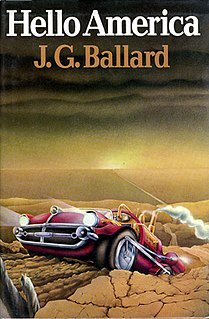
Hello America is a science fiction novel by British writer J. G. Ballard, published in 1981. First edition cover designed by Bill Botten. The plot follows an expedition to a North America rendered uninhabitable by an ecological disaster following an energy crisis.

The Day of Creation is a 1987 novel by British writer J. G. Ballard.
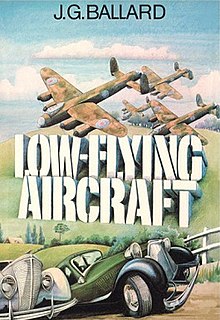
Low-Flying Aircraft and Other Stories is a collection of science fiction short stories by British writer J. G. Ballard published in 1976.

Miracles of Life is an autobiography written by British writer J. G. Ballard and published in 2008.

Kingdom Come is a 2006 novel by the British writer J. G. Ballard. It is the last novel written by him before his 2009 death. The book deals with the supposed blurry line between consumerism and fascism. It also deals with the suburban environment and the psychogeography of such places.
"Studio 5, The Stars" is a short story by British author J. G. Ballard. First appearing in the February 1961 edition of Science Fantasy ; it was reprinted in the collection Billennium the following year. It later appeared in The Four-Dimensional Nightmare (1964), Vermilion Sands (1971) and The Complete Short Stories of J. G. Ballard (2006).
"Deep End" is a short story written in 1961 by British author J. G. Ballard. It first appeared in the May 1961 edition of New Worlds and then in the 1962 collection The Voices of Time and Other Stories followed by The Complete Short Stories of J. G. Ballard: Volume 1 in 2006. The tale is typical of Ballard's dystopian science fiction.

Billenium is a short story by British author J. G. Ballard, first published in the January 1962 edition of Amazing Stories and in the Billennium collection. It later appeared in The Terminal Beach (1964), Chronopolis and Other Stories (1971), and The Complete Short Stories of J. G. Ballard: Volume 1 (2006). With a dystopian ambience, "Billennium" explores themes similar to Ballard's earlier story "The Concentration City", of space shortages and over-crowding.
"Minus One" is a short story by British author J. G. Ballard; it was first published in the June 1963 edition of Science Fantasy. It was later reprinted in the 1967 collection The Disaster Area, and then later in the larger The Complete Short Stories of J. G. Ballard: Volume 1 anthology (2006).

Climate fiction is literature that deals with climate change and global warming. Not necessarily speculative in nature, works may take place in the world as we know it or in the near future. The genre frequently includes science fiction and dystopian or utopian themes, imagining the potential futures based on how humanity responds to the impacts of climate change. Technologies such as climate engineering or climate adaptation practices often feature prominently in works exploring their impacts on society. Climate fiction is distinct from petrofiction which deals directly with the petroleum culture and economy.

















